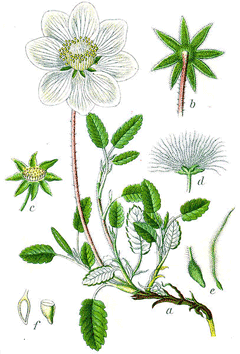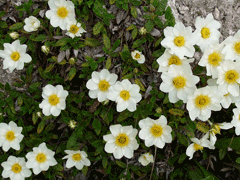 |
|
http://commons.wikimedia.org/wiki/File:Dryas_octopetala_Sturm43.jpg |
 |
| http://commons.wikimedia.org/wiki/User:Griensteidl |
Translate this page:
Summary
Bloom Color: White. Main Bloom Time: Early summer, Late spring. Form: Prostrate, Spreading or horizontal.
Physical Characteristics

 Dryas octopetala is an evergreen Shrub growing to 0.1 m (0ft 4in) by 1 m (3ft 3in) at a medium rate.
Dryas octopetala is an evergreen Shrub growing to 0.1 m (0ft 4in) by 1 m (3ft 3in) at a medium rate.
See above for USDA hardiness. It is hardy to UK zone 2. It is in leaf all year, in flower from June to July. The species is hermaphrodite (has both male and female organs) and is pollinated by Insects.
It can fix Nitrogen.
Suitable for: light (sandy), medium (loamy) and heavy (clay) soils. Suitable pH: mildly acid, neutral and basic (mildly alkaline) soils. It cannot grow in the shade. It prefers moist soil.
UK Hardiness Map
US Hardiness Map
Synonyms
Plant Habitats
Ground Cover;
Edible Uses
Edible Parts:
Edible Uses: Tea
The leaves are used as a tea substitute[2, 13, 46, 183].
References More on Edible Uses
Medicinal Uses
Plants For A Future can not take any responsibility for any adverse effects from the use of plants. Always seek advice from a professional before using a plant medicinally.
Antidiarrhoeal Astringent Digestive
The entire plant, harvested just before or at flowering time is astringent and digestive[9]. An infusion is used as a stomach tonic, and also as a gargle for treating gingivitis and other disorders of the mouth and throat[9].
References More on Medicinal Uses
The Bookshop: Edible Plant Books
Our Latest books on Perennial Plants For Food Forests and Permaculture Gardens in paperback or digital formats.

Edible Tropical Plants
Food Forest Plants for Hotter Conditions: 250+ Plants For Tropical Food Forests & Permaculture Gardens.
More

Edible Temperate Plants
Plants for Your Food Forest: 500 Plants for Temperate Food Forests & Permaculture Gardens.
More

More Books
PFAF have eight books available in paperback and digital formats. Browse the shop for more information.
Shop Now
Other Uses
The plant makes a good ground cover for spring bulbs, though it is not strongly weed suppressive[200]. Slow-growing at first, it then forms a dense mat[197]. Plants should be spaced about 30cm apart each way and they form a carpet, the branches rooting at intervals along the stems[208].
Special Uses
Food Forest Ground cover Nitrogen Fixer
References More on Other Uses
Cultivation details
Landscape Uses:Alpine garden, Ground cover, Rock garden. Easily grown in ordinary gardening soil[1, 11], preferring a sunny position[4]. Prefers limestone soils[1]. Prefers a gritty well-drained peaty soil[188]. A sub-shrub, producing annual stems from a woody base[11, 200]. A good plant for a rock garden[1], it succeeds on banks and on walls[188]. A very ornamental plant[1]. The sub-species D. octopetala hookeriana has been shown to produce nitrogen nodules on its roots due to a symbiotic relationship with certain soil bacteria, in the same way as peas and beans[212]. It has been assumed here that the species type can also do this[K]. Some of the nitrogen is utilized by the growing plant but some can also be used by other plants growing nearby[200]. Established plants strongly resent root disturbance[200]. Special Features:Attractive foliage, Not North American native. For polyculture design as well as the above-ground architecture (form - tree, shrub etc. and size shown above) information on the habit and root pattern is also useful and given here if available. An evergreen. A clumping mat former. Forming a dense prostrate carpet with a limited spread [1-2]. The root pattern is fibrous dividing into a large number of fine roots [1-2].
References Carbon Farming Information and Carbon Sequestration Information
Temperature Converter
Type a value in the Celsius field to convert the value to Fahrenheit:
Fahrenheit:
The PFAF Bookshop
Plants For A Future have a number of books available in paperback and digital form. Book titles include Edible Plants, Edible Perennials, Edible Trees,Edible Shrubs, Woodland Gardening, and Temperate Food Forest Plants. Our new book is Food Forest Plants For Hotter Conditions (Tropical and Sub-Tropical).
Shop Now
Plant Propagation
Seed - best sown in pots a shady cold frame or sheltered place outdoors as soon as it is ripe[200]. Stored seed requires stratification and should be sown as soon as possible. The seed usually germinates in 1 - 12 months or more at 20°c[200]. When they are large enough to handle, prick the seedlings out into individual pots and grow them on in the greenhouse for their first winter. Plant them out into their permanent positions in late spring or early summer, after the last expected frosts. Division of self-layered shoots in early spring[1, 200]. Cuttings of half-ripe wood with a heel, July/August in sharp sand in a frame[1, 200].
Other Names
If available other names are mentioned here
Native Range
NORTHERN AMERICA: Canada, Yukon, Alberta, British Columbia, United States, Alaska, Colorado, Idaho, Oregon, EUROPE: Finland, United Kingdom (U.K.), Ireland, Iceland, Norway, Svalbard and Jan Mayen, Austria, Germany, Poland, Slovakia, Russian Federation-European part, European part, Ukraine, Albania, Bulgaria, Bosnia and Herzegovina, Greece, Croatia, Italy, North Macedonia, Montenegro, Romania, Serbia, Slovenia, Spain, France,
Weed Potential
Right plant wrong place. We are currently updating this section.
Please note that a plant may be invasive in one area but may not in your area so it's worth checking.
Conservation Status
IUCN Red List of Threatened Plants Status :

Growth: S = slow M = medium F = fast. Soil: L = light (sandy) M = medium H = heavy (clay). pH: A = acid N = neutral B = basic (alkaline). Shade: F = full shade S = semi-shade N = no shade. Moisture: D = dry M = Moist We = wet Wa = water.
Now available:
Food Forest Plants for Mediterranean Conditions
350+ Perennial Plants For Mediterranean and Drier Food Forests and Permaculture Gardens.
[Paperback and eBook]
This is the third in Plants For A Future's series of plant guides for food forests tailored to
specific climate zones. Following volumes on temperate and tropical ecosystems, this book focuses
on species suited to Mediterranean conditions—regions with hot, dry summers and cool, wet winters,
often facing the added challenge of climate change.
Read More
Expert comment
Author
L.
Botanical References
1117200
Links / References
For a list of references used on this page please go here
Readers comment
| Add a comment |
|
If you have important information about this plant that may help other users please add a comment or link below. Only comments or links that are felt to be directly relevant to a plant will be included. If you think a comment/link or information contained on this page is inaccurate or misleading we would welcome your feedback at [email protected]. If you have questions about a plant please use the Forum on this website as we do not have the resources to answer questions ourselves.
* Please note: the comments by website users are not necessarily those held by PFAF and may give misleading or inaccurate information.
To leave a comment please Register or login here All comments need to be approved so will not appear immediately.
|
Subject : Dryas octopetala
|
|
|
|